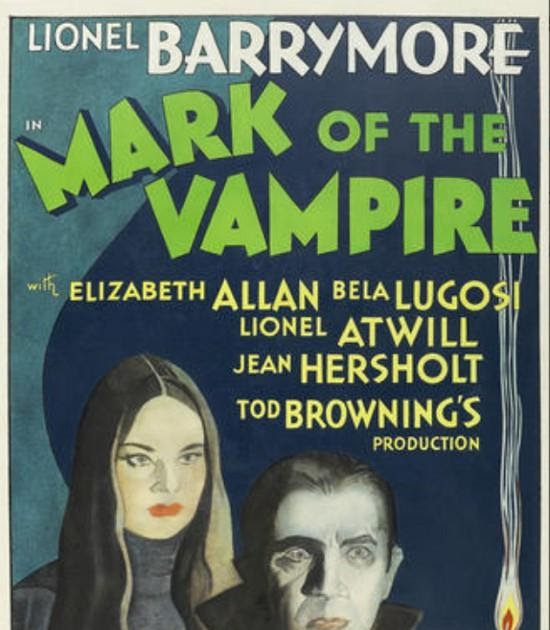Mark of the Vampire is a 1935 MGM horror movie (yes, MGM did make a few horror movies in the 30s) directed by Tod Browning. And it’s a vampire movie starring Bela Lugosi. In this movie he’s Count Mora rather than Count Dracula (the name change being necessitated by the fact that Universal were in a mood to sue anybody who dared to use the name Dracula).
Mark of the Vampire provokes violently mixed reactions among horror fans, the main reason being a certain plot twist, but I won’t say any more for fear of revealing spoilers.
My main reservation about this movie has always been based on the presence of Lionel Barrymore in the cast. In fact he gets top billing. Lionel Barrymore was the biggest ham in the history of cinema and he could annoying.
There’s also the vexed Tod Browning question. Browning has his admirers but he has a lot of detractors and the doubts about his abilities as a director mostly stem from dislike of his 1931 Dracula. I don’t hate Dracula as much as some people do. It has its problems with poor pacing and excessive staginess but it has its merits as well and I’ve slowly warmed to it, to an extent at least.
Mark of the Vampire is a remake of Browning’s 1927 mega-hit London After Midnight which had starred Lon Chaney Sr. It’s impossible to compare the two films since the last surviving print of London After Midnight was destroyed in a vault fire in the late 1960s.
The biggest problem with Mark of the Vampire is that it is partially a lost film as well. It ran into massive problems with the Production Code. It also suffered from a great deal of studio interference and was previewed many times and re-edited many times. Consequently this is a movie that was hacked to pieces. About a quarter of the movie was lost, and most of the cut scenes do not survive. All we have is a horribly butchered version. Unfortunately it appears that many of the scenes that were cut were scenes involving Bela Lugosi and Carol Borland – in other words some of the best bits of the movie were removed and destroyed. As a result there is simply no way to make a proper judgment on this movie.
The movie (or what remains of it) opens with the murder of a nobleman, Sir Carol Borotyn. The setting seems to be central Europe. Mosty it takes place in the late Sir Carol’s castle. It is set in contemporary times, in 1934 in fact.
Dr Doskil (played by Donald Meek) believes Sir Carol was killed by a vampire. The villagers and the servants tend to agree.
The police officer in charge of the case, Inspector Neumann (Lionel Atwill), scoffs at such superstitious nonsense. He believes he is dealing with a straightforward murder. Sir Carol was a very rich man. Several people stood to gain financially by his death – including his daughter Irena Borotyn (Elizabeth Allan), her fiancé Fedor Vincente (Henry Wadsworth), Irena’s guadian Baron Otto (Jean Hersholt).
Then Professor Zelin (Lionel Barrymore) arrives on the scene. He’s the Van Helsing character. He has no doubt that they are dealing with a vampire.
In fact probably two vampires. Local legends point to a certain Count Mora and his daughter Luna. The Count is naturally played by Bela Lugosi, with Carol Borland as Luna.
Both Irena and Fedor are attacked by the vampire but survive. Professor Zelin has plans to track the vampires down in their lair and destroy them.
Then we get that major plot twist.
I saw this movie years ago on VHS. Seeing it now on Blu-Ray obviously makes it easier to appreciate the visuals, and it is a good-looking movie. James Wong Howe’s cinematography is a major asset.
Dracula had made quite an impact in 1931 with its stunning gothic imagery. Mark of the Vampire is more polished and perhaps visually more impressive than Dracula. The special effects (such as the bats) are done quite well. The gothic atmosphere in the castle is achieved superbly. There are some wonderful spooky images. Luna’s flying scene is a highlight.
Barrymore is not quite as irritating as I’d feared. Lionel Atwill is good. Bela Lugosi and Carol Borland are not called upon to do anything more than look disturbingly creepily vampiric and they manage that very convincingly. Elizabeth Allan makes a good heroine without being insipid.
The minor supporting players are there to provide comic relief. There’s way too much of that in the movie and it’s excruciating.
It has to be admitted that the amazingly convoluted plot makes no sense at all. None whatsoever.
Tod Browning had an up-and-down career during the 1930s, with the downs outnumbering the ups. He only made a couple of movies after Mark of the Vampire. The Devil-Doll, made the following year, is a rather good mad scientist movie. I’m quite fond of his final movie, Miracles for Sale (1939).
I liked Mark of the Vampire a bit more this time around. It’s livelier and more technically sophisticated than Dracula and it’s fairly entertaining. Whether you will decide that the ending ruins the movie is up to you. Recommended.




